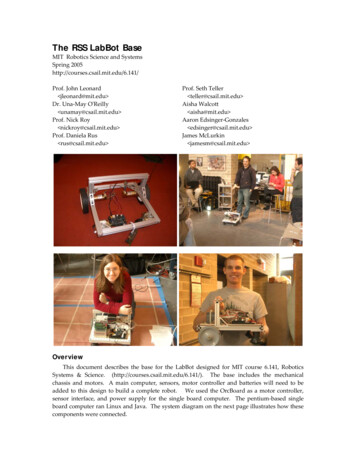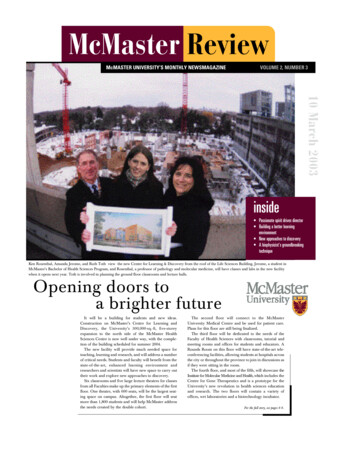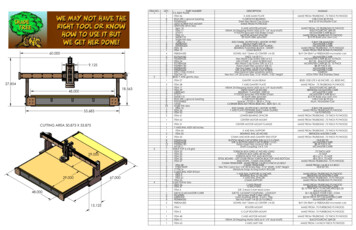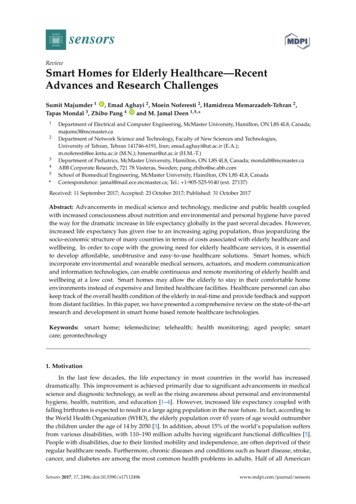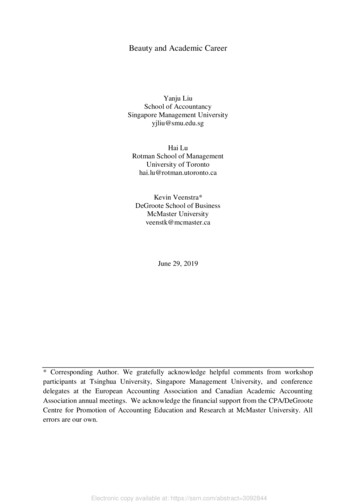
Transcription
USING PROFESSIONAL PRACTICE MODELS
USING PROFESSIONAL PRACTICE MODELS:A PHENOMENOGRAPHIC STUDY OF PROFESSIONALPRACTICE EXPERTS’ CONCEPTIONSBy BARBARA LYNN JONES, BScN, MWSA Thesis Submitted to the School of Graduate Studiesin Partial Fulfilment of the Requirements for the DegreeMaster of ScienceMcMaster University Copyright by Barbara Lynn Jones, July 2012
Descriptive NoteMcMaster University MASTER OF SCIENCE (2012) Hamilton, Ontario (Nursing)TITLE: Using Professional Practice Models: A Phenomenographic Study of ProfessionalPractice Experts’ Conceptions AUTHOR: Barbara Lynn Jones, BScN (University ofToronto), MWS (Institute for Christian Studies) SUPERVISOR: Dr. Colleen McKeyNUMBER OF PAGES: xi, 106ii
AbstractThe centrality of health care practice environments to the safety and quality ofcare that patients receive is well established. Hospitals often develop and implement aprofessional practice model (PPM) as one strategy to improve practice environments.In the United States, the incentive of magnet hospital designation is a driving force inPPM implementation. In Ontario, Canada, despite the lack of magnet hospitaldesignation potential, many hospitals have also implemented PPMs. However, thereappear to be differences in how PPMs are implemented in Ontario. There is a need toevaluate the utility of PPMs in assisting Ontario hospitals toward quality practiceenvironments.This phenomenographic study examined professional practice experts’conceptions of PPM implementation and use in Ontario acute care hospitals. It offersunique insight into the complexity of these phenomena. The findings indicate that PPMimplementation is a dynamic and emergent phenomenon that occurs in cyclical phases ofgrowth or renewal followed by periods of reduced activity or “lulls”.Seven categories of PPM use are described (a) creating alignment/consistency, (b)supporting evidence-based practice, (c) enabling interprofessional practice, (d) enhancingprofessional accountability, (e) enabling patient-centred care, (f) creating/ strengtheninglinkages, and (g) strategic positioning professional practice. Variations and differentlevels of use were evident within each category. As well, categories exhibitedhierarchical relationships to one another, with more foundational uses providing supportfor higher level uses.iii
Three structural themes were identified (a) model design and structure, (b)professional practice leadership, and (c) organizational support. These themes workindividually and synergistically, within and across the categories to influence theutilization and potential impact of the PPM. Progressively fuller and more complex useof the PPM appears to occur under increasingly intense influence of the structural themes.The phenomenographic analysis provides new information about the relationshipswithin and among the categories of PPM use and enables a more powerful understandingof the phenomenon than has been previously described. This provides insight as to howorganizations might maximize return on investment with PPM implementation. Sevenkey recommendations arising from the study were identified:1. Ensure an intentional PPM design aligned with articulated implementation goals.2. Design PPMs to ensure that all elements work together.3. Ensure PPM elements and implementation goals align with hospital strategic plan.4. Commit to adequately resourcing all PPM elements to function optimally.5. Design the PPM such that professional practice leader roles are appropriatelypositioned within the organization to achieve implementation goals.6. Set clear expectations related to participation in the PPM and ensure accountability isdemonstrated.7. Anticipate that PPM implementation is longitudinal and create space for and celebratePPM growth, emergence.iv
AcknowledgementsThe completion of this work feels like an incredible accomplishment to me.There were many significant life bumps along the way that interrupted and delayed myability to focus attention here and there were many times that I thought I would notfinish. Through those times, my committee members Dr. Gladys Peachey and Dr.Catherine Tompkins and particularly, my supervisor Dr. Colleen McKey held the faithfor me and patiently encouraged my heart and supported my mind to stay engaged. Iwant to acknowledge their significant contribution to this thesis; not only their keeninsights, scholarly prowess and enthusiasm, but their compassionate and humanistic carefor me. It gave me courage to persevere through what seemed like a continuous streamof challenges.I also must acknowledge the generosity and patience of the McMaster UniversitySchools of Nursing and Graduate Studies for granting extensions and leaves thatprolonged my program of study but enabled me to continue despite those bumps alongthe way. I’m very proud to be a graduate of the McMaster University MSc program.For their generous research funding support, I gratefully acknowledge theMcMaster School of Nursing Graduate Program (In-course Research Scholarship, 2009)and the Nursing Leadership Network of Ontario (Research Award, 2010).My good friend, colleague and fellow professional practice scholar, Dr. SaraLankshear provided ongoing support, advice, encouragement and also very helpfulassistance working up the original graphics for outcome space schematics. Thanks Sara,v
you’re a rock! I’d also like to thank my gifted colleague, Ms. Jaclyn Bucik for taking myvision for the schematics and creating the final reality herein.The Professional Practice Network of Ontario (PPNO) allowed me to tap into theexpertise of its membership and always enables the sharing of scholarly work. Thankyou PPNO.I must also acknowledge two outstanding nursing leaders and my greatestmentors, Dr. Gail Donner and Dr. Sue Matthews. Both have been steadfast guides,inspirational role models and each, in her own way has shaped me as a professional, anacademic and a nurse throughout my career. I am truly blessed to have the counsel ofsuch exceptional women.And finally, my heartfelt thanks to those professional practice experts who tooktime out of their very busy schedules to participate in my study. It is my hope that thiswork reflects your professionalism, your passion, and your wisdom. Thank you so much!vi
DedicationThis thesis is dedicated with love to:My mother, Joyce Margaret (Lloyd) Jones, who has always believed so stronglyin me that I had to believe in myself and from whom I’ve learned what motherly pridemeans. Thank you Mum, for always, always being there with love.My daughter, Ayden Nella Jessie Margaret van Koot who basically grew from alittle girl into a beautiful, strong and kind young woman during the completion of thiswork. Ayden, I’m so proud that we are graduating together this year. I believe in you;you will shine ever more brightly in high school and I can help you with your papers!My husband, Douglas Edward McLean. You have truly shown me whatresilience and determination mean in this past year and I am so very thankful that you arehere to share this with me. Doug, more than anyone, you have sacrificed so that I couldpursue this goal; the achievement of it is yours as much as mine. Thank you!My father, George Gordon Jones, who journeyed beyond this world before I couldfinish this. Thank you Dad, for inspiring me towards intellectual curiosity and a love ofwords and for always expecting me to strive for more. Rest peacefully.vii
Table of ContentsDescriptive Note . iiAbstract . iiiAcknowledgements .vDedication . viiTable of Contents . viiiLists of Figures and Tables .xList of All Abbreviations and Symbols . xiChapter 1 – Introduction .1Chapter 2 – Review of Literature.5Magnet Hospitals & Professional Practice Environments .5Professional Practice Models & PPM Utility .7Professional Values .11Governance Model .11Care Delivery Model.12Professional Relationships .13Compensation & Rewards .14Practice Environment Outcomes.15Summary .21Chapter 3 – Methods .24Statement of the Problem .24Primary Research Question.24Secondary Research Question.24Phenomenography.24Sampling .26Ethical Considerations .27Data Collection .28Data Analysis .29Chapter 4 – Findings .33Model Implementation .33Model Use Descriptive Categories . 38Create Alignment/Consistency .38Enable Evidence-based Practice .41Enable Interprofessional Practice .42viii
Enhance Professional Accountability .45Enable Patient Centred Care .46Creating and Strengthening Linkages .48Strategic Positioning of Professional Practice .50Summary .54Structural Analysis of Model Use .55Model Structure and Design .56Professional Practice Leadership .62Organizational Support .66Summary .69Chapter 5 – Discussion .72Model Elements and Design .72PPM Implementation .78PPM Utility .79Maximizing PPM Utilization .82Limitations .86Implications for Future Research .87Conclusion .88References .89Appendix A. Essential Professional Practice Structure Elements and Descriptions,Grouped by Theme .98Appendix B. Letter of Study Introduction .100Appendix C. Letter of Information .101Appendix D. Demographic Data Sheet .104Appendix E. Interview Tool .105Appendix F. Supplemental Data Sheet .106ix
List of Figures and TablesFigure 1. University of Maryland Medical Center Professional Practice Model .10Table 1. Differences between US and Ontario Professional Practice ModelImplementation .23Figure 2. Cyclical Process of PPM Implementation . 38Figure 3. Categories of PPM Use .55Figure 4a. Outcome Space Schematic 1 .70Figure 4b. Outcome Space Schematic 2 .71Figure 4c. Outcome Space Schematic 3 .71x
List of Abbreviations and SymbolsAmerican Association of Colleges of Nursing (AACN)American Nurses Credentialing Center (ANCC)Best Practice Spotlight Organization (BPSO)Emergency Room (ER)Hospital Quality Alliance Composite Score (HQACS)Nursing Assistant (NA)Nursing Worklife Model (NWI)Ontario Nurses’ Association (ONA)Per Patient Day (ppd)Principle Investigator (PI)Professional Practice Environment(s) (PPE) (PPEs)Professional Practice Leader(s) (PPL) (PPLs)Professional Practice Model(s) (PPM) (PPMs)Professional Practice Network of Ontario (PPNO)Registered Nurse(s) (RN) (RNs)Registered Nurses’ Association of Ontario (RNAO)Registered Practical Nurse(s) (RPN) (RPNs)United States (US)University of Pittsburgh Medical Center (UPMC)xi
MScN Thesis – Barbara Lynn Jones; McMaster University – Nursing 1Chapter 1IntroductionThe centrality of health care practice environments to the safety and quality of carethat patients receive is well established (Kramer & Schmalenberg, 2008; SpenceLaschinger, 2008). Stemming from the American Academy of Nursing magnet hospitalresearch (Cook, Hiroz, & Mildon, 2006), an enduring focus on practice environments overthe past two decades has given rise to the implementation of PPMs, as replacement ofmore traditional nursing practice models (Arford & Zone-Smith, 2005; Zelauskas &Howes, 1992). Indeed, “professional models of care” are one of the forces of magnetismin the ANCC Magnet Recognition Program (ANCC, 2008; Arford & Zone-Smith, 2005).The implementation of a PPM within a health care organization is a major changeinitiative and requires an extensive investment of human resources. While there is afairly large body of literature related PPMs, there has been little attempt to evaluatemodel utility. As well, most references that describe the actual utility of PPMs inmoving organizations toward their quality practice environment goals are from the US,where the incentive of magnet hospital designation is a driving force. Because magnethospital designation is exclusively a nursing system designation, the largest body ofliterature discussing PPMs has a nursing focus and a significant emphasis on PPMutilization at the patient care unit level (Cone, Conner McGovern, Barnard, & Reigel,1995; Hastings, 1995; Rose & Reynolds, 1995; Rusch, 2004; Walker, 2001; Zelauskas &Howes, 1992).
MSc Thesis – Barbara Lynn Jones; McMaster University – Nursing 2In Ontario, Canada, despite the lack of magnet hospital designation potential,many hospitals have implemented PPMs (Mathews, & Lankshear, 2003). However, thereappear to be differences in how these models are implemented in the Ontario context.Mathews and Lankshear (2003) reported sixteen “essential elements” of ideal PPMs, asgenerated by members of the PPNO during a PPNO quarterly meeting.Perhaps as a response to the introduction of the Regulated Health Professions Act(1993), PPMs in Ontario tend to focus on interprofessional processes and structures,rather than a distinct focus on nursing. This is evidenced by the following elementsreported by Mathews and Lankshear (2003) (a) interprofessional nature, (b)multidisciplinary roles (beyond nursing), and (c) collaborative practice principles. Inaddition, identified elements supporting a view that PPMs in Ontario tended towardcorporate implementation versus a focus on unit based implementation were (a) purposewith a corporate/strategic view, (b) senior administrative support and linkages, (c) nonsilo, cross program approach; (d) clear linkage to organizational mission and vision, (e)well-established linkages within the organization, and (f) corporate and unit basedcouncil structures. This is likely in part, a response to the advent of programmanagement administrative structures in Canadian hospitals (Davis, Heath, & Reddick,2002; Lankshear, 2007; Mathews & Lankshear, 2003).There is a paucity of literature addressing PPM use in Ontario hospitals. Mathewsand Lankshear (2003) noted that “although most organizations espouse a professionalpractice culture, there is great variability in the degree of operational supports in place toachieve that culture” (p. 71). They further commented that professional practice leaders
MSc Thesis – Barbara Lynn Jones; McMaster University – Nursing 3(PPLs) were hampered by ambiguity and a lack of empirical evidence as to which are thekey elements needed for successful implementation of PPMs. In addition, legislationgoverning Ontario’s public hospitals was seen as a barrier to full implementation ofPPMs because it limited scope of practice of some professional groups and affordeddifferent status to credentialed versus non-credentialed practitioners, particularlyphysicians.Matthews and Lankshear (2003) further reported that the existence of a PPL wasthought by PPNO members to be an essential element of a PPM. Lankshear (2007) notedthat more than 60 health care organizations in Ontario had PPLs. In summary, althoughthe use of PPMs in the Ontario hospital practice context is a relatively commonphenomenon, there has been no systematic study of exactly why (what goals they arehoping to achieve) and how (how are the models chosen/designed and used) hospitals areimplementing PPMs. The elemental design and utility of these models is not wellunderstood or documented and the scant documentation that exists in the literature islargely US in origin. Given the differences described above between the US and Ontariocontexts and given that PPM implementation is a complex and resource intensiveendeavor (Storey, Linden, & Fisher, 2008) that may or may not be supporting hospitals tostrengthen their professional practice environments (PPEs), further examination of theuse of PPMs in Ontario is warranted.The primary purpose of this study was to begin to fill the gap in knowledgeidentified above and describe how professional practice experts in Ontario acute carehospitals implement and use PPMs to improve the practice environment (PPE) of their
MSc Thesis – Barbara Lynn Jones; McMaster University – Nursing 4hospitals. In addition, descriptions of elements of the models in use in Ontario acute carehospitals were elicited.
MSc Thesis – Barbara Lynn Jones; McMaster University – Nursing 5Chapter 2Review of LiteratureMultiple electronic databases (Canadian Health Network, CINAHL, Cochrane,ERIC, HealthSTAR, MEDLINE, SAGE Nursing & Health Sciences, SAGE Management& Organization, Pubmed, Scholar’s Portal, Social Sciences citation index, Web ofScience) were searched using a variety of terms. Terms included professional practiceelements/essential elements, PPMs/frameworks/structures, nursing practicemodels/frameworks/structures, practice models/frameworks/structures, use of, utilizationof, clinical governance, shared governance and combinations of these. The searches werenot restricted based on year, given that research and publication around this topic crossedseveral decades. Manual searches of references generated by these searches and fromknown seminal sources yielded additional references.Magnet Hospitals & Professional Practice EnvironmentsIn the early 1980’s, a severe nursing shortage prompted the American Academyof Nursing to commission a policy study, the purpose of which was to identify thoseorganizational characteristics that both attracted and retained nurses. These outlierhospitals were called “magnets” (ANCC, 2008b). Fourteen “forces of magnetism” wereidentified in the study, including quality of nursing leadership, organizational structure,staffing, PPMs, quality of care, autonomy, interdisciplinary relationships and professionaldevelopment (ANCC, 2008b). These forces or characteristics were felt to bedistinguishing features of magnet hospitals.
MSc Thesis – Barbara Lynn Jones; McMaster University – Nursing 6Kramer and Schmalenberg (1988a & 1988b) continued to research magnethospitals in a study that mapped eight characteristics of well-run corporate companiesonto a sample of magnet hospitals. Their findings indicated there was a strongcorrelation between the characteristics of magnet hospitals and those of successfulcorporations. The study lent support for the primacy of nursing in the achievement of thecorporate goal of quality patient care and as a central study focus.Patient care is the product that is produced. In the magnet hospitals, it wasrecognized that the main department in this product line is nursing The centraltheme of all the excellent companies is that everything, all other departments,must support the product line (Kramer & Schmalenberg, 1988b, p.17).This research set the tone for another decade of research related to the magnet hospitalcharacteristics and nursing professional practice systems.In a review of this research, Scott, Sochalski, and Aiken (1999) concluded thatthere were common perceptions, across a broad range of study samples, sites andmethods, about the central attributes of a quality nursing PPE. These attributes includedthe centrality of the nurse-patient relationship, professional autonomy (the ability tocontrol one’s own practice, including participation in clinical decision making),professional recognition and status, and interprofessional (particularly nurse-physician)collaboration. Additionally, the importance of visionary and transformational nursingleadership was consistently identified as a central attribute.These attributes correspond with those characteristics deemed by the AACN to bethe “hallmarks” of a professional nursing practice environment. Additionally, the AACN
MSc Thesis – Barbara Lynn Jones; McMaster University – Nursing 7(2002) identified professional accountability, executive level nursing leadership,professional development support, including clinical advancement programs, and the useof clinical practice technology support as hallmarks.A valid critique of this body of research is that there is an inherent selection biasin studying only magnet hospitals. In response to this, Lacey et al. (2007) conducted across-sectional comparative study of magnet, magnet-aspiring and non-magnet hospitals,using the Individual Workload Perception Scale to measure 3, 337 staff nurses’ views onorganizational support, workload, satisfaction and intent to stay. The findings supportstatistically significant differences between the three types of hospitals with relativelystronger PPEs evident in magnet and then magnet-aspiring hospitals compared with nonmagnet hospitals. Another cross-sectional comparative study, conducted by Patrician,Shang and Lake (2010) compared RNs’ responses across twenty-three Army MedicalDepartment hospitals based in the US, utilizing the Practice Environment Scale of theNursing Worklife Index. They found that across all hospitals, practice environmentscores were consistently the strongest predictor of negative work outcomes, including jobdissatisfaction, emotional exhaustion and intent to leave. In this study, lower practiceenvironment scores were also the strongest predictor of fair to poor care quality ratings.Professional Practice Models & PPM UtilitySeveral references in the PPM literature reviewed attempted to offer a definitionof PPM (Arford & Zone-Smith, 2005; Cava, 2008; Hoffart & Woods, 1996; Massaro etal., 1996; O’Rourke, 2006; Zelauskas & Howes, 1992). All of these definitions orexplanations included discussions of values, structures and processes that supported
MSc Thesis – Barbara Lynn Jones; McMaster University – Nursing 8professionals’ autonomous practice through their involvement in shared clinical decisionmaking and control over the practice environment. The terms “model”, “structure” and“framework” are used synonymously in the literature and will be represented by the termPPM in this report.There is evidence in the literature of relationships among the articulated goals,essential elements and identified utility of PPMs. Several commonly articulated goalsrelated to PPM implementation include improving and standardizing quality of care,improving both patient and staff satisfaction, and enhancing work effectiveness and fiscalefficiency (Davis, Heath, & Reddick, 2002; Lake, Keeling, Weber, & Olade, 1999;Massaro et al., 1996; Wolf, Hayden & Bradle, 2004). As well, there is a strong themerelated to enhancement of the professional role in terms of clarity, accountability andempowerment as a goal of PPM implementation (Arford & Zone-Smith, 2005; Cava,2008; Davis, Heath, & Reddick, 2002; Girard, Linton, & Besner, 2005; Hoffart &Woods, 1996; Latta & Davis-Kirsch, 2011; O’Rourke, 2003 & 2006; Wolf, Hayden, &Bradle, 2004). These goals echo the characteristics of magnet hospitals outlined earlier.Additionally, and again echoing the magnet hospital research, there was acknowledgmentin the literature about the utility of PPMs in forwarding hospital goals of professionalrecruitment and retention.The inclusion of specific elements in the PPM design is related to articulatedgoals of PPM implementation. How the PPM is used to achieve the identified goals, or inother words, the model utility is intrinsically connected to the elements included in themodel and the design of their interaction within the model and within the organization. It
MSc Thesis – Barbara Lynn Jones; McMaster University – Nursing 9follows that in order to achieve the goals of PPM implementation, whatever they may be,an intentional model design process needs to occur and must include model utilityplanning (Rose & Reynolds, 1995). In essence, the planning process needs to answer thequestions, what do we need to include and how do we use what we put in place to get towhere we want to be from where we are now? In several instances, the identification ofdesign elements for PPMs represented in the literature was facilitated by some process ofempirical inquiry with staff, in the form of focus groups, surveys and/or interviews, withthese efforts supported by literature review (Cava, 2008; Davis, Heath, & Reddick, 2002;Girard, Linton, & Besner, 2005; Ingersoll, Witzel, & Smith, 2005; Lake, Keeling,Weber, & Olade, 1999; Mathews & Lankshear, 2003; Wolf, Boland, & Aukerman,1994). Other authors referred only to the literature or spoke theoretically about theessential PPM elements (Arford & Zone-Smith, 2005; Hoffart & Woods, 1996;O’Rourke, 2003 & 2006). Latta and Davis-Kirsch (2011) maintained that “thedevelopment of a theory-derived, organizationally compatible PPM comes alive inpractice only when it is pragmatically developed and clearly articulated” (p. 581).Of all sources, the one most often cited in the PPM literature is Hoffart andWoods (1996). These authors outlined five subsystems/elements of PPMs (a) governancemodel/management approach, (b) care delivery model, (c) professional values, (d)professional relationships, and (e) compensation/rewards. They conducted an analysis ofexisting literature, comparing five existing PPMs that were documented in the lit
the way. I'm very proud to be a graduate of the McMaster University MSc program. For their generous research funding support, I gratefully acknowledge the McMaster School of Nursing Graduate Program (In-course Research Scholarship, 2009) and the Nursing Leadership Network of Ontario (Research Award, 2010).
